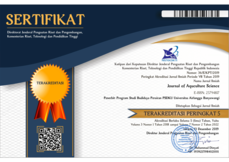Abundance and Diversity of Bacteria on Catfish Nursery Rearing (Clarias gariepinus) With Closed Water System (Close Water System)
Downloads
This research aimed to identify types of bacteria existed in nursery rearing pond of catfish (Clarias gariepinus) using closed water system. The observed data include bacterial abundance and diversity in the water and in the fish digestion system, fish growth and water quality. This research was performed in the media of 3 concrete pools with the size of 3 x 1 x 0.8 m3 containing fish stock spreading of 3000 tail / pond. The obtained results showed that the highest abundance of bacteria was found in the surface and the bottom of pond C with the abundance number of 3,0 x 104and 1,2 x 103for aerobic and anaerobic bacteria, respectively. Moreover, it was figured that the dominant bacterial species found in the water and the gastrointestinal tract were from the genus of Bacillus, Clostridium and Lactobacillus. Meanwhile, water quality in the pond was observed in the normal range with the temperatures of 28 - 30 oC, pH (6.0 - 7.0), DO (4.5 - 5.7 ppm), ammonia (0.06 - 0.03 ppm), nitrite (0 ppm) and nitrate (0 - 5 ppm).
Keywords: Type of bacteria, catfish (Clarias gariepinus), Closed water system.
Boyd CE, Lichtkoppler. 1979. Water Quality Management in Pond Fish Culture. International Center For Aquaclture. Agriculture Experimental Station. USA.
Boyd, C. E. 1982. ter Quality Management in Pond Fish Culture. Elsevier Scientific Publishing Company. Amsterdam-oxford. New York. Duborow RM, Crosby DM, Brunson MW. 1997. Ammonia in Fish Pond. Southern Regional Aquaculture Center. SRAC
Publ. No. 463.
Ebeling, J.M., Timmons, M.B., Bisogni, J.J. 2006. Engineering analysis of stoichiometry of photoautotrophic, autotrophic and heterotrophic removal of ammonia-nitrogen in aquaculture systems. Aquaculture 257, 346-358
Effendi, H. 2000. Telaah Kualitas Air
: Bagi Pengelolaan Sumberdaya dan Lingkungan Perairan. Fakultas Perikanan dan Ilmu Kelautan. IPB. 259 Hal.
Fukuda R. 2000. Microbial Degradation of Proteinaceous Organic Matter in
Marine Environments, University of Tokyo. Tokyo.Japan.
Hippe H, Anderseen JR, Gottschalk
G. 1992. The genus Clostridium non-medical. Di dalam Balows A, Truper HG, Dwarkin M, Harden W, Schleifer K-H, The prokaryot. A Handbook in The Biology of Bacteria :
Ecophysology, isolation, identification, Application. Vol
II. Edisi ke-2. New York : Springer-Verlag.
Kelautan dan Perikanan. 2015. Kelautan dan Perikanan dalam Angka tahun 2015. Pusat Data, Statistik dan Informasi. Kementerian Kelautan dan Perikanan.
Nikoskelainen S, Ouwehand AC and Bylund G. 2003. Immune enhancement in rainbow trout (Oncorhynchus mykiss) by potential probiotic bacteria (Lactobacillus rhamnosus). Fish & Shellfish Immunology IS
: 443-452.
Nagata T, Meoq B, Kirchman DL. 2003. Microbial Degradation of Dissolved Organic Matter in Sea Water, Journal of Limnology and Oceanography 48, 745-754.
Nikoskelainen S, Ouwehand AC, Salminen S & Bylund G (2001a). Protection of rainbow trout (Oncorhynchus mykiss) fromfurunculosis byLactobacillus rhamnosus.Aquaculture198:2 29 - 236
Prihadi, T.H. 2005. Pengelolaan Budidaya Ikan Secara Lestari di Waduk (Studi
Kasus di Perairan Waduk Cirata, Jawa Barat). [Disertasi]. Bogor : Sekolah Pascasarjana, Institut Pertanian bogor.
White, D. 1995. The Physiology and biochemistry of Prokaryot. New york. Oxford Univ Pr.
Woon BH. 2007. Removal of nitrat nitrogen in conventional wastewater treatment plants. Skripsi. Faculty of Civil
Engineering. University Teknologi Malaysia
Cowan and Steel. 1993. Manual for Microbiology Identification of Medical Bacteria. Edition III. Cambridge University Press. New York. Cambridge. Hal 42- 45.
Jumiarni, D. 2012. Isolasi dan Identifikasi Bakteri Sedimen Waduk. Jurnal Exacta 8(1): 1-
Sudarmono, PP. 2016. Mikrobioma: Pemahaman Baru tentang Peran Mikroorganisme dalam Kehidupan Manusia. Editorial Mikrobioma 4(2): 71-75.



















